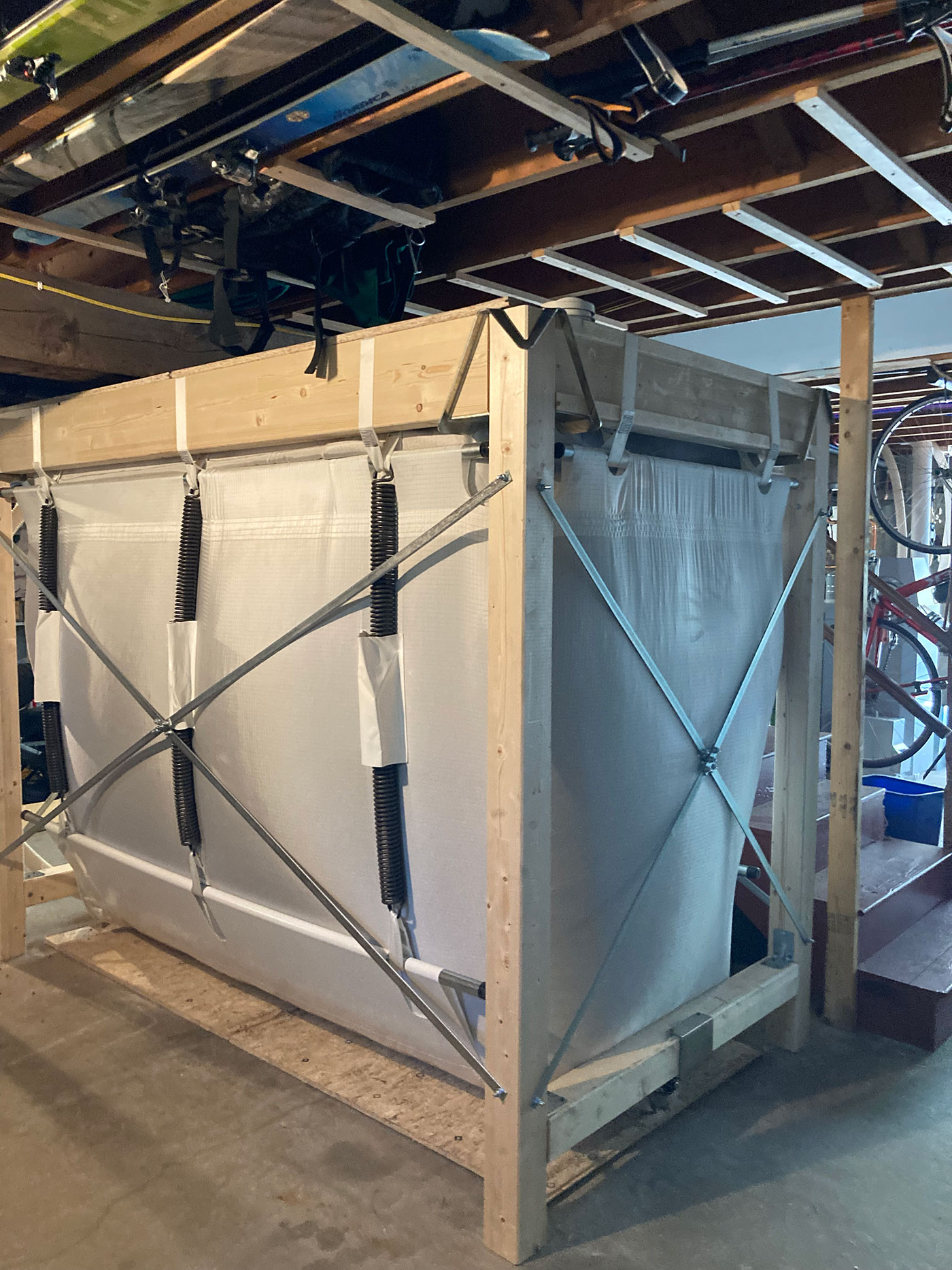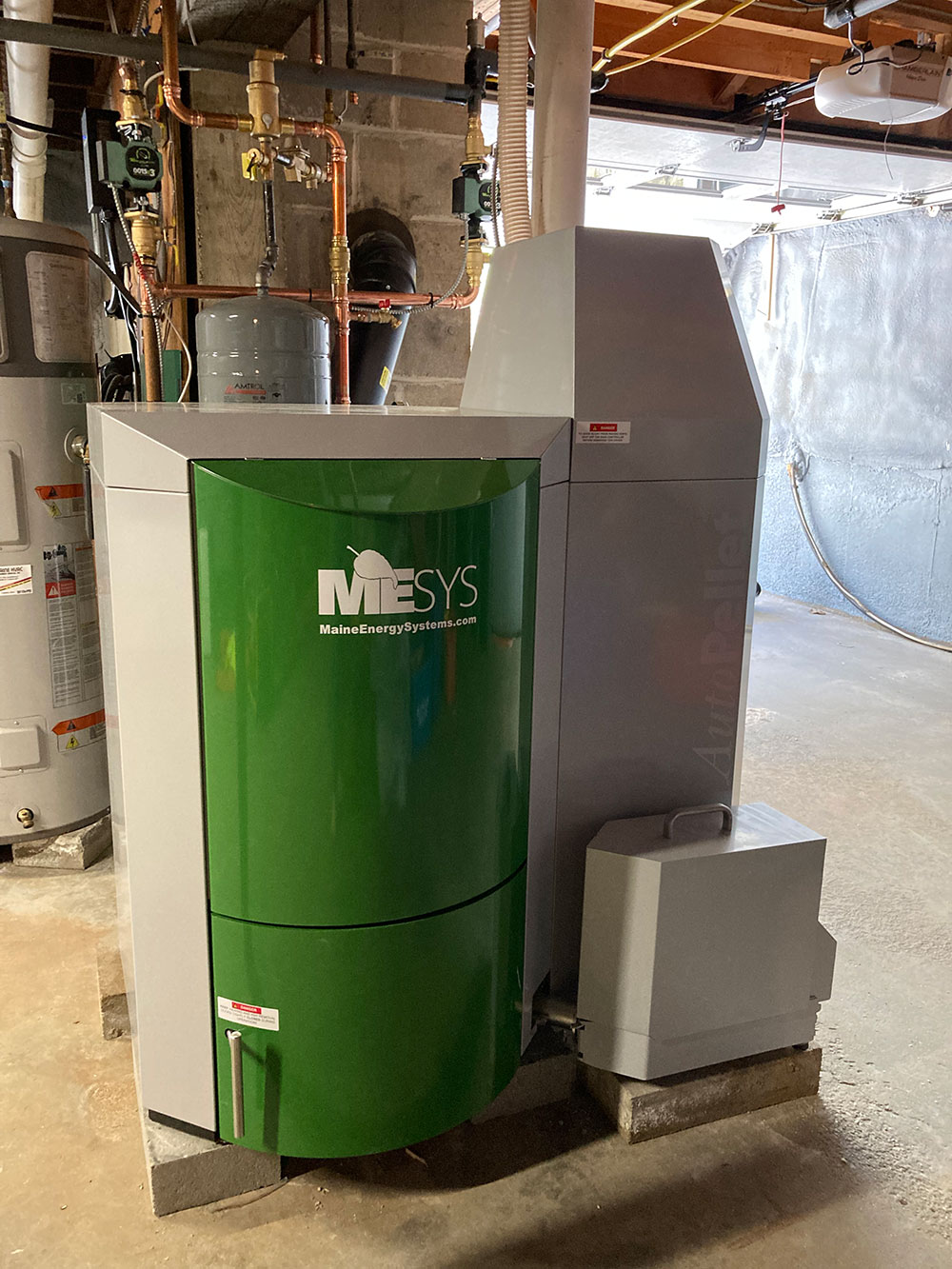A couple years ago my husband and I moved into a home that, like 60% of houses here in Maine, burns oil for heat. When we were ready to switch to an alternative heating system, we knew we would be looking for options that helped move us away from fossil fuels, weren’t going to break the bank, and could fit relatively seamlessly within the existing infrastructure of our home, which is plumbed for baseboard hydronic heat. We ultimately decided to invest in a wood pellet boiler, and so far we are glad we did.
 After some additional research, we decided to work with a Maine-based company that holds a license to brand and sell Austrian pellet boilers manufactured by ÖkoFEN, and they had several options to choose from based on the application. The Maine company also offers pellet delivery to customers on their own tanker trucks, blown right into the bin in bulk. They pointed us to a local contractor who would purchase and install the system for us as a complete package. We scheduled the installation a couple months out, and once they got started the whole process took two days. The installer did a truly excellent job, and he hauled away and recycled our old boiler and tank, too. With today’s high energy costs, wood also seemed to be a good choice because the cost is relatively stable compared to oil and gas. We expect to save around 40-50% on heating costs next winter. Wood heat isn’t the cleanest approach out there, but i
After some additional research, we decided to work with a Maine-based company that holds a license to brand and sell Austrian pellet boilers manufactured by ÖkoFEN, and they had several options to choose from based on the application. The Maine company also offers pellet delivery to customers on their own tanker trucks, blown right into the bin in bulk. They pointed us to a local contractor who would purchase and install the system for us as a complete package. We scheduled the installation a couple months out, and once they got started the whole process took two days. The installer did a truly excellent job, and he hauled away and recycled our old boiler and tank, too. With today’s high energy costs, wood also seemed to be a good choice because the cost is relatively stable compared to oil and gas. We expect to save around 40-50% on heating costs next winter. Wood heat isn’t the cleanest approach out there, but i t’s a big improvement over fossil fuel heat.
t’s a big improvement over fossil fuel heat.
During the research process we also very seriously considered heat pumps. Today’s heat pump systems can handle cold Maine winters, and they provide air conditioning as well, a plus as Maine summers get hotter. They also provide significant emissions reductions over oil and propane, particularly in Maine where much of our energy mix is sourced from renewables already. Maine has excellent heat pump incentives, which are a great option for many homeowners, so I encourage people to check out Efficiency Maine’s heat pump programs as well. In the end, we opted for wood because of the cost competitiveness that the rebates provide.
For a long time, the Natural Resources Council of Maine has recommended switching from oil or propane to a fossil-fuel-free alternative, and now I can as well. However, there are a couple lessons I learned I wanted to pass on if you might be considering this option. Our walk-out basement with garage bays is configured for a very easy installation, and homes with less-accessible basements might have a tougher time. Also, you need to have plenty of room for your pellet bin. I was surprised by how large it is; the footprint is about twice the size of our old 225-gallon oil tank and runs from floor to ceiling. The bin holds 3.75 tons of pellets that should last us more than half the winter. Fortunately, we had space for it and were able to place it exactly where we wanted to minimize issues. Another option would have been a smaller custom bin, requiring more frequent deliveries.
An important question to ask when researching wood pellet furnace options is about the type and source of wood pellets you’d be getting. From a forest resources and carbon perspective, it’s best to burn pellets made from residual wood, meaning scraps created in sawmills and during timber harvesting, not pellets made from sawlogs and marketable timber. However, it’s difficult to know the exact type of wood going into pellets, and if you use a pellet manufacturer in Maine, it’s likely they’re using a mixture of these. The pellets we bought came from a Maine company that primarily uses wood from Maine forests but also sources from Canada as well. Local wood is definitely the way to go if you have the option.
Although we haven’t had a need to run the new boiler since early May when we made the switch, we tested the new rig out and were pleased with how much quieter it was than the oil burner. And even though there was never a smell to the oil, our basement has a woody aroma now.
Wood heat was the right move for us, and I recommend looking into fossil fuel alternatives for energy and heating that are right for your home. Doing so will not only help meet the goals laid out in the statewide Climate Action Plan, it’ll also help reduce your energy costs now and into the future. Luckily for Maine, there are plenty of options that fit the bill.
—Melanie Sturm, NRCM Forests & Wildlife Director










Thanks for sharing this! In addition to the benefits described, you can also feel good about reducing carbon dioxide emissions when switching from oil to bulk wood pellets- 54% reduction from day 1. https://northernforest.org/greenhouse-gases-and-wood-pellet-heat/
How is the cost of buying pellets in bulk? I actually eliminated my pellet stove to install more oil baseboard since the cost of pellets increased by $50/ton.
What’s the efficiency of the new pellet boiler and how does the feed work? Can you go away for extended periods of time?
Thanks!
The wood pellets costed $310 per ton, which is equivalent to roughly 120 gallons of oil. There’s more information here that’s helpful: https://www.maine.gov/energy/heating-fuel-prices
In terms of efficiency, I’d suggest taking a look at the technical specifications of any boiler you’re considering. It’s generally equivalent to oil. The system we have has a large hopper that feeds into a smaller hopper daily that’s fully automatic, so it can run while we’re away. The ash only needs to be emptied once a month or so.
Melanie
Thanks so much for writing this article! My wife and I are moving this coming spring from Oregon into a house in Brooks that has oil-fired hydronic heating and are excited about switching to pellet fuel. I would love to know what the rough footprint of your hopper is and the output of your model in BtUs.
The output of our model is 68,000 BTUs, but the company we used makes models with different outputs as well. Our hopper measures 5ft (width) x 8ft (length) x 6.5ft (height).
Justin – I live in Oregon, currently in a home with Natural Gas-powered in-floor radiant hydronic heating, but soon moving to a town on the north OR coast where there is no Natural Gas supply, and I am interested in exploring cleaner HVAC options anyway. While every contractor so far is steering me to a heat pump system using existing duct work from old forced-air electric furnace system, but hydronic heating with pellet fuel is very appealing so I am interested to hear if you proceeded and what your experience has been. Specifically, whether you had trouble finding a company with expertise to install; what your maintenance experience of system has been; your running costs in OR; and (important to me) whether the system is QUIET when actively running, and whether you can have multiple zones. Thanks for any input.